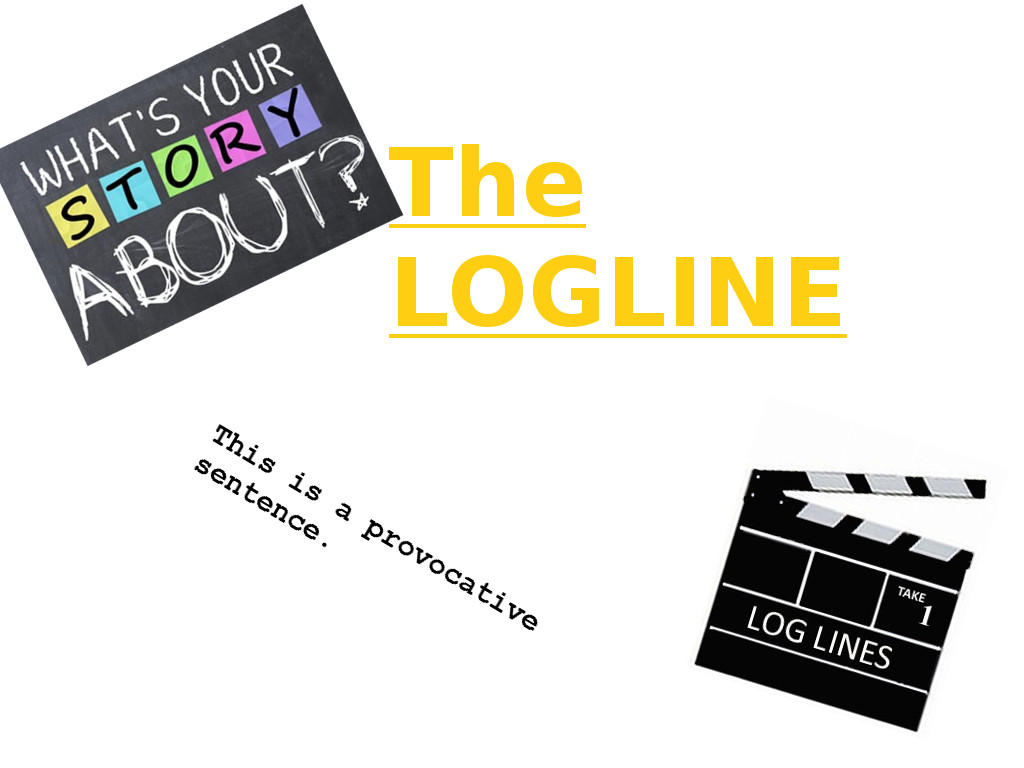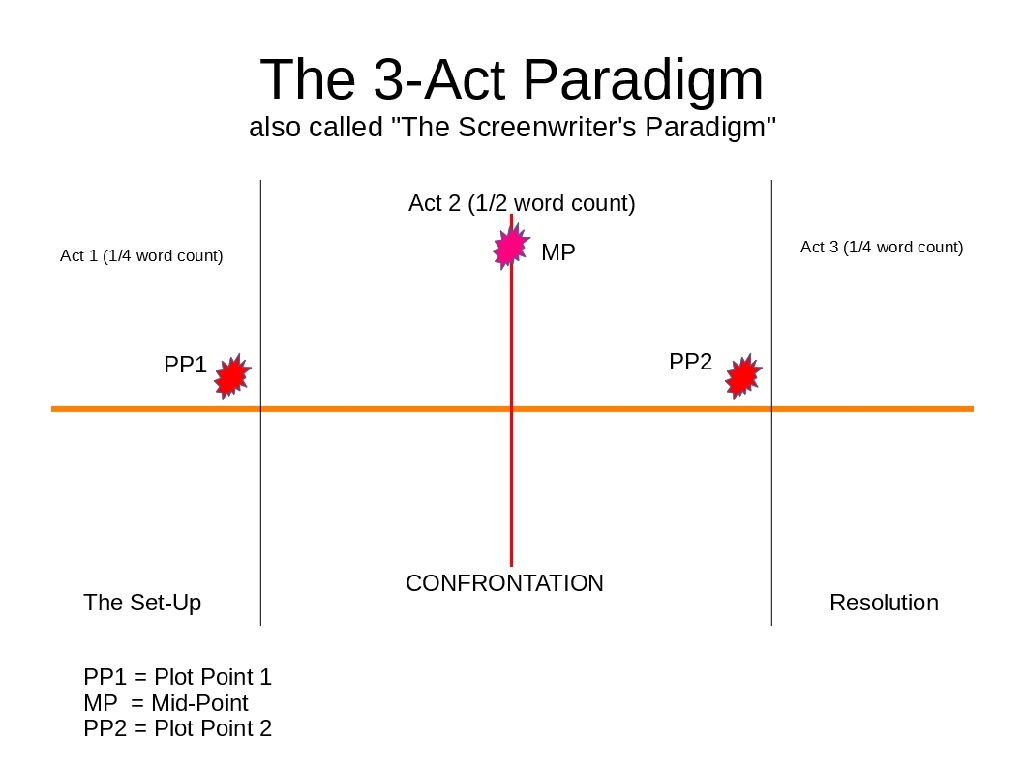How To Plot A Novel Like A Well-Timed Mechanical Ambush

Step One
So you want to tell a tale. What do you do? Just sit down and start writing it from the beginning? Do you even know where to begin?
Well, the first step is a “simple” requirement…or so it would seem.
Your task, O Jedi Scribe, is to write one stinking sentence.
That’s it. One sentence. Now to create that sentence, you’re going to have to boil the entire narrative essence of your Epic Tale down to one sentence which focuses on the line of action and the character (or characters). When you achieve the objective, you will know exact what it is you are writing and why. They say the hardest thing about writing is knowing what to write. Your finished sentence will brilliantly distill what it is you are writing.
Write a paragraph or pages of notes attacking your idea from every angle. Then take that raw material and slash it down to one perfectly worded sentence. Make mind maps if that helps you “see” your material.
But when you are done, you will have a sentence that tells your story. If you’ve ever read TV Guide descriptions of what a show is about, this is exactly what you are attempting to do. In Hollywood, this is called the logline. In fact, this is exactly what you are doing here – writing a logline that tells the story of your novel.
Now here’s a set of guidelines that are even more specific to the task.
Your sentence must focus on a protagonist, the goal, and the antagonist or antagonistic force opposing the protagonist.
Don’t use character names in your sentence; use character types: a cop, a hooker, a rocket scientist. Add a good adjective to add some depth to the character: a burned-out hooker.
Clearly present the protagonist(s) goal.
Describe the antagonist or antagonist force which opposes the hero.
Make it clear that the protagonist(s) are pro-active to the action, not reactive.
Detail the stakes or ticking time bomb that the characters are working to achieve or beat.
Don’t just tell your story with your logline, sell it as well. When you write the perfect logline of your novel, you’ll have the best thing to tell people when they find out you’re a writer. Everyone always asks: “What’s your story about?” That’s when you rattle off your logline.
So now we just need a good example of all of the above in action. Here’s my logline for Special Task Force: GREEN MAJIK #1 “Pretty Hate Machine” now available at www.bluefalconpress.com:
“A maverick detective, a Gonzo journalist, and a has-been porn star fight to expose the federal government’s involvement in the worst schoolyard shooting in history while a super-secret strike unit infiltrates the center of the cyclone, the factory where little girls are turned into suicide juggernauts and unleashed.”
Are we on the same sheet of music now? Is it as clear as the water in a Caribbean lagoon? This is Step One in writing a great genre novel. In the next lesson, I’m going to show you how to diagram all the important turning points in your story and structure your idea inside the 3-Act Paradigm or what needs to be in the Beginning, what to do with the Middle (a lot of writers get bogged down here and I will show you how to stay out of the mud) and how to wrap it all up with a satisfying End.
Stay tuned.

Welcome to Step Two in the Blue Falcon Press plot planning process.
What I’m about to reveal here is something professional screenwriter’s already know backwards and forwards. This diagram was originally brought to the world by the late, great Syd Field. Now here is something novelists need to internalize: this schematic works Jim Dandy as a template for your novel as well as a screenplay. I’ve written EVERY novel of mine using the Paradigm above to map out the major movements and turning points in my plots. EVERY. ONE. This diagram keeps you on target, keeps you focused, and keeps you from writing crap that has no business being in your story.

The first thing to do in figuring out your paradigm is write a sentence which describes how the story is going to END. Then do the same thing for the BEGINNING. In my novels, the beginning is always the INCITING INCIDENT. It is the event that starts all the other story dominoes falling. In Pretty Hate Machine, this is the Sadie Hawkins attack on her school. Next, decide what PP1, PP2, and MP are. Let me explain what a Plot Point is. A plot point is defined as any incident, episode or event that “hooks” into the action and spins it around into another direction. (from Syd Field’s SCREENWRITER’S WORKBOOK) Now notice where your plot points fall: at the end of Act 1 and at the end of Act 2.
The Mid Point is some kind of incident, episode, or event that occurs in the middle of ACT 2 and breaks ACT 2 into two halves of dramatic action. Act 2 becomes two halves joined together by the Mid-Point. The first half of Act 2 now has a target you know – the Mid-Point.. The second half of Act 2 has another target to write towards, everything that happens after the Mid-Point and concludes with Plot Point 2.
Let’s illustrate how this works by examining the Peter Jackson remake of King Kong. I’m not using Pretty Hate Machine to illustrate this because it will ruin the wonderful surprise for readers of the book. I’m not going to spoil that surprise for you. In King Kong, Act 1 ends with Plot Point 1 which in this case is when the expedition reaches Skull Island. The Mid-Point of the story is when King Kong shows up for the first time, taking the girl into the jungle with him. So, the first half of Act 2 shows all the incidents that take place exploring the Island. The second half of Act 2 details the girl’s relationship with Kong and her shipmates attempts to find her and rescue her. Plot Point 2 is when Kong is captured and the ship leaves for New York. See how that works? It makes Act 2 absolutely manageable now. No reason to fear Act 2 anymore.
Let’s discuss briefly the purpose each act serves. Act 1 is known as the Set-Up. It shows your character’s in their normal world before the real meat of the tale kicks in. Plot Point 1 is really where the steam of the story picks up and spins us into The Confrontation which occupies the entire length of Act 2. Act 2 is where you put your heroes in a tree and throw rocks at them. Act 2 ends with Plot Point 2 which spins the story around into another direction, which is the straight down nose dive into The Resolution or Act 3. This is where your heroes regain the initiative and turn the tables on the opposition, smacking them down smartly. Or if you’re into tragedies and such, this is where the heroes are defeated by the opposition. I don’t like those kind of endings so I don’t use them. I believe the good guys will always best the bad guys. That’s how I roll.
Next, impose the length restrictions of the screenplay on your novel. In a screenplay, Act 1 is one-forth the length of your script. For a 90 minute show, that’s roughly 22 and a half pages. Act 2 is half the length of the script or 45 pages. Act 3 is the same length as Act 1. In a novel, you do this by dividing your word count by 4. GREEN MAJIK novels are 100,000 words in length. So Act 1 and 3 are roughly 25,000 words in length; Act 2 is 50,000 words, which is divided into two chunks of 25K by the Mid-Point. Simple Simon.
Here’s your homework assignment. 1st, get Syd Field’s book The Screenwriter’s Workbook. It’ll be the best $16 you’ll ever spend. Next, read Pretty Hate Machine and tell me what Plot Point 1 and 2 are and what the Mid-Point is. Email your answers to [email protected]. Once you know what you are looking at, these events are easy to spot.
Next, we will talk about planning the most important part of your novel: your characters. See you there.

Characters. The heart and soul of good fiction. Character decisions and actions should dictate plot development, not the other way around.
The first thing I do with a character is visualize that character. The best way to do this is find a representative picture of your character. I pick a movie or TV personality to represent the character. Once I can “see” a character, “hearing” the character is easy for me.
I use Randy Ingermanson’s Snowflake Method (http://www.advancedfictionwriting.com/articles/snowflake-method/) to get my character skeletons fleshed out on paper rather than following Syd Fields character creation process. Both are very similar. I’ve found Randy’s process to get to the core of a character essence instantly.
The first step is to write a one-page dossier which deals with 7 key points:
Name
Ambition (what the character wants abstractly)
Story Goal (what the character wants concretely)
Conflict (what prevents the character from reaching the goal)
Epiphany (what the character learns, how the character changes)
A One Sentence Summary (think of this as the character’s logline)
A One Paragraph Summary (expand the logline to one paragraph)
Now, let’s do this for a character. This is what my dossier on Special Agent Mallory Hammond looks like for the forthcoming GREEN MAJIK adventure, Splatterpunk. You are getting a sneak preview into Mallory’s continuing story line in the next novel. Hope it makes you want to read the first one now.
Agent Hammond’s ambition in #2 is the same as it was in #1: To expose the underground cult she knows is operating all over the world.
Her story goal is to hold the alligator farm long enough to get one of the fry specimens out for her squid expert to examine.
The source of Mallory’s conflict in this tale is the FBI hierarchy, Homeland Security and the mysterious Men In Black from MAJESTIC.
Mallory’s epiphany in this adventure is that the cult she is pursuing has infiltrated the government at all levels.
The One Sentence Summary: Mallory Hammond finds her investigation under literal siege when Homeland Security arrives to take over and silence her with national security.
The One Paragraph Summary: When DHS shows up being led by a MIB and attempts to seize the investigation by force, Hammond uses the Hostage Rescue Team like infantry to form a blockade and temporarily put the aggression into a stand-off while she gets one of the fry specimen prepped for smuggling out in an ice cooler brought by the boys to house the PBR in. She has Fender send her state police as escorts to ensure they get out without being ambushed by black ops. She goes to see the squid expert Fender has located. She takes the fry specimen to Dr. Donovon West of Miskatonic University located in Arkham, Massachusetts.
There are two more steps in the Snowflake Method to fully flesh out the character. I do the next step fully and the final step partially.
Take your paragraph summary of your character’s story line and write a full page, page and a half treatment which tells the entire story arc of the character inside your novel.
This is what the treatment looks like:
Special Agent Mallory Hammond receives an urgent phone call from BRAD FENDER. The shit has hit the fan. The Director is under siege from Homeland over her little monster hunt. Homeland is en route to her location, whatever she has to do to get the evidence out she better do now. Hammond hangs up on him and starts deploying the HRT to hold a line and prevent the invaders from getting access to the farm house. She enlists Ronson and Gage to assist her in snagging one of the specimens. It is a harrowing experience getting that damn squid out of the tank and into a small shipping crate filled with sea water. When the three emerge back outside lugging the shipping crate, the rest of the HRT are blockading the Homeland Security convoy. The black Suburbans are filled with MIB agents. The squid gets stowed in the trunk of Hammond’s GSA sedan. Then she goes to the skirmish line and meets the MIB in charge: MR. ADAMA. A terse exchange. The MIBs back out of the drive to allow Hammond and the HRT to exfil. Hammond goes directly to the airfield. At the airfield, she gets on a commercial flight with the squid to fly directly to Arkham, Massachusetts.
The campus of MISKATONIC UNIVERSITY. Fender is blowing up her phone again. She was suppose to fly back to D.C.! Prior to the balloon going up, Fender had found her squid expert, one DR. DONOVAN WEST of the Miskatonic Oceanographic Institute. She tells him he’s just going to have to hunt her down and hangs up. Then she drops her FBI issued smart phone into a fish tank and proceeds to turn Dr. West’s conceptual universe upside down. Dr. West has been in touch and go negotiations with a producer from Animal Planet for a reality TV series featuring his expedition to find a live giant squid in the wild. After seeing the squid fry and hearing Hammond’s tale about what was found in Louisiana – his TV series idea takes a quantum leap. He rudely excuses himself to call the producer – get the hell out here with cameras now! When the cameras burst onto the scene, her first instinct is to punch aqua danger boy’s lights out. Dr. West is something of an orator and quickly points out the insulating advantages she might have transferring her investigation from the FBI to Animal Planet and his reality TV show. And, yeah, Mallory Hammond sees the advantages immediately as well.
A cultist hit team tries to take back the avatar. Mallory Hammond engages in a blistering gun battle and foot chase with the hit team, flanked by a daredevil Animal Planet cameraman. The intense footage is aired immediately along with the earlier taped testimony of Hammond’s detailing how the squid fry was taken into custody. Now the FBI witch hunt to drum Hammond out of the bureau has hit a sensational snag – the TV series is an instant mass phenomenon. Mallory Hammond is now the bureau’s biggest PR asset.
The final step is to create a full blown character biography detailing all the usual stuff: name, rank, serial number, hair color, ethnic heritage, birth day, birth place, schools, all that down in the weeds detail. I don’t get wrapped around the axle about the character biography. When I have everything I’ve just revealed, I know everything I need to know to start writing.
In other words, I now know what to write.
For the sake of covering all the bases, use this link (https://drive.google.com/open?id=0BxA1mVe3Sc_tSzlmaUZuX1UzUWc) to download a character biography template from me.
The next installment is going to wrap up this discussion of all my secret plotting methods. See you there.

Here we are in the final stretch. Once you’ve done all your character work, you’ve got a lot of story synopses that tell the whole story from each character’s piece of the story. Now we roll it up into one blueprint, the 4-page treatment.
First, take you logline in step one and expand that into a paragraph made up of 5 and ONLY 5 sentences.
Sentence one should cover your BEGINNING or the Inciting Incident as I refer to it.
Sentence two will cover Act 1 to the first Plot Point.
Sentence three covers Act 2 to the Mid-Point.
Sentence four covers Act 2 after the Mid-Point to the second Plot Point.
Sentence five covers Act 3, your climax.
Next, take your paragraph of five sentences and expand that into a clean one-page treatment. Expand your five sentences into five separate paragraphs. Each paragraph will describe exactly the same territory as each sentence did above. Therefore:
Paragraph one covers the BEGINNING.
Paragraph two fleshes out Act 1 to PP1.
Paragraph three details Act 2 to the Mid-Point.
Paragraph four covers the rest of Act 2 up to PP2.
Paragraph five will detail Act 3 completely to the END.
What comes next is what Syd Field calls the “kick in the ass” assignment: the four page treatment. Note that this procedure is pretty much the same in both the Snowflake Method and in Syd Fields’ Screenwriter’s Workbook. Here’s how we break it out:
Page one will cover all of Act 1.
Page two will cover Act 2 up to the Mid-Point.
Page three covers the second half of Act 2.
Page four covers all of Act 3.
Notice that we’ve written this four page treatment according to the same space requirements we’ve described in step 2 by dividing your total word count into 4 equal chunks. Act 1 and 3 occupy one-fourth of the total length of the story and Act 2 is one half of the total. Work on this until you have a perfect four page treatment. Single space or double space? I single space it to get more info per page and can fit in all the character story lines into the final document.
The Snowflake Method gives you two extra steps in that you write up a complete scene list chapter by chapter and Syd Field does the same thing but uses index cards to make the scene list, one card for each scene.
I don’t do the scene lists. Once I have a tight four page treatment, I stop planning there and start the actual writing of the novel. For me, the four page treatment is all I need. At this point, I know EXACTLY what I’m writing. So I start writing.
Here’s why I don’t do scene lists: once I start writing, the characters will come to life and will ALWAYS take over the story with stuff you could have never seen coming in the planning stage. This is where the magic happens. In fact, what actually happens in Pretty Hate Machine is a perfect example. What happens in the novel as it reads today IS NOT what I thought was going to happen from the Mid-point on. What happens in the novel is solely the result of the characters taking over and showing me a much better series of events than I could have ever cooked up at the macro level of planning. It’s that great surprise I’ve eluded to but haven’t ruined with a spoiler. The first thing to go out the window for me is that scene list. It always changes for me once the characters take over driving the bus. So why waste time writing something that’s almost always going to change? The four page treatment is all the blueprint I need to start writing confidently.
Give your characters the freedom to come to life. Otherwise, you will run the risk of turning the characters into marionettes that are just moving around the story because the plot says they have to do this, whether they want to do that or not. Let them live, O Jedi Scribe!
They say there are two kinds of novelists: planners and pantsers (flying by the seat of your pants). Pantsers just start writing with little or no prior planning, thinking that by just writing, at some point, the characters will reveal the plot and the story will write itself. For the beginner, this is dangerous. You will probably write a lot of junk that has no business being in the story and you could end up in a dead end – not knowing what the hell to do next. I’m three-quarters planner and one quarter pantser. I only let the pantser come into play AFTER I know exactly what it is I’m writing, knowing in advance what the targets are I’m moving towards.
Only write scenes that either move the story forward or reveal something essential about character or necessary exposition like backstory. If the material doesn’t do one of those two things, CUT IT OUT. Ruthlessly. I don’t care how much you like it. If you’re not moving the story relentlessly forward, then it doesn’t belong. We’re not literary writers. We’re genre writers which means, ultimately, we’re writing to be read, by as many readers as we can attract.
The formula I’ve revealed here will work for ANY genre tale you want to tell. It’s not just for action-horror novels like I write. It works for any story that follows the eternal hardwired blueprint we call the 3-Act Structure. Deviate from this timeless structure at your own risk.
We’re done here. I hope you’ve gotten something out of this. Now go write your Great American Genre Novel. And when you do, let me know how this has worked out for you. I’d like to know.